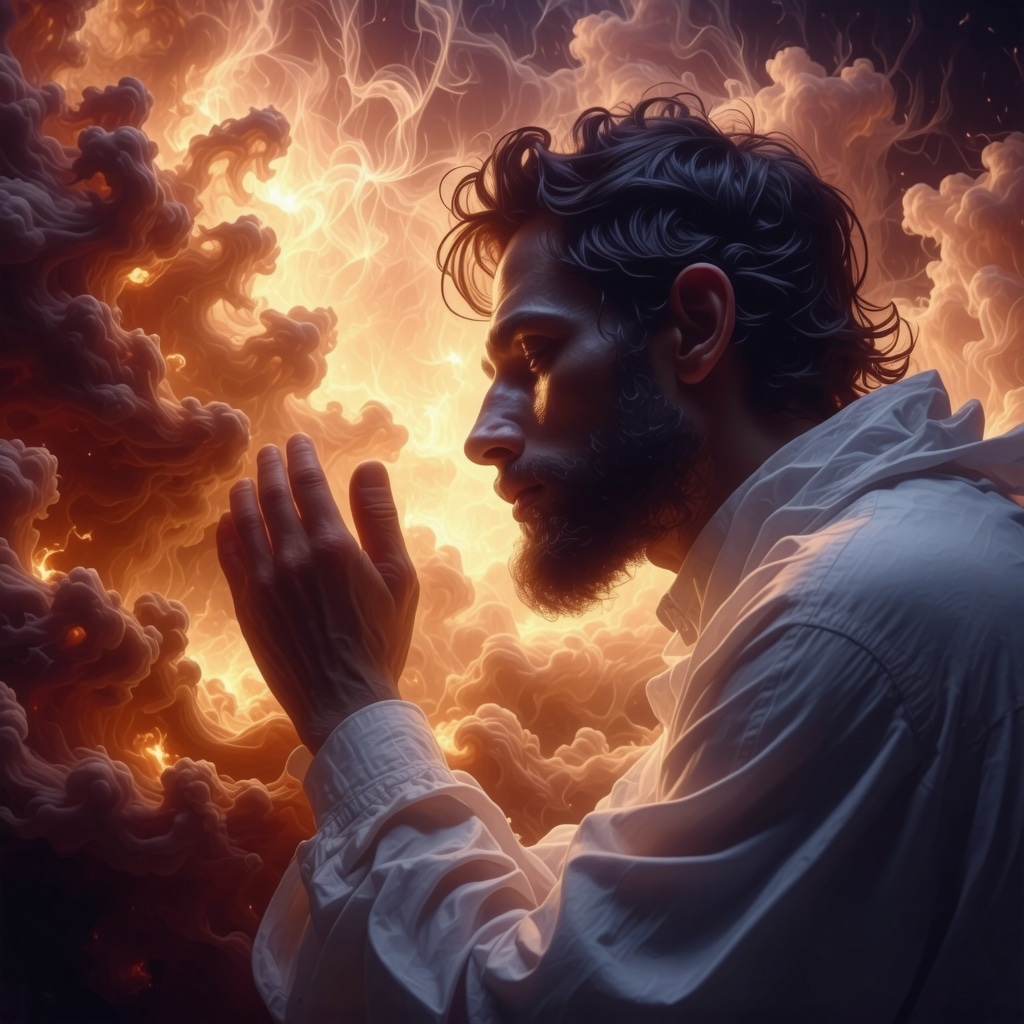My Personal Journey into Shia Dream Interpretation
Ever since I was young, I’ve been fascinated by dreams and their mysterious messages. One night, I experienced a vivid dream involving a snake, which left me pondering its deep significance in Islamic tradition. This personal encounter sparked my curiosity about how dreams serve as divine messages in Shia Islam and how sacred symbols can guide our spiritual journey.
Discovering Sacred Symbols in Dreams
In my exploration, I learned that dreams are often filled with symbols that carry profound meanings. For example, dreaming of a snake can symbolize various divine messages, such as warnings or spiritual transformation, depending on the context. According to Islamic dream interpretations, understanding these symbols requires insight into personal circumstances and spiritual state.
What Do Divine Messages Look Like in Our Dreams?
From my experience, divine messages often appear as clear visions or subtle signs, guiding us towards righteousness or warning us of potential dangers. I remember dreaming of a peaceful mosque, which I later realized symbolized spiritual growth and faith. These dreams are not random; they are sacred messages that can strengthen our connection with Allah and His prophets, especially when interpreted with sincerity and knowledge.
Why Are Sacred Symbols Important in Shia Dream Interpretation?
In Shia tradition, sacred symbols in dreams serve as divine tools to communicate hidden truths. They can reveal future events, moral lessons, or divine guidance. Recognizing these symbols requires spiritual insight and often, consultation with knowledgeable scholars. For instance, dreaming of a dove might symbolize divine purity and peace, aligning with the spiritual messages conveyed through sacred visions.
How Can I Better Recognize Sacred Symbols and Divine Messages in My Dreams?
Practicing mindfulness before sleep, reciting Quran, and seeking Allah’s guidance can enhance our ability to interpret dreams. Additionally, studying trustworthy sources like Islamic dream dictionaries can deepen your understanding of dream symbols. Remember, every dream is a unique sacred message, and approaching it with sincerity helps unlock its divine meaning.
If you’re passionate about exploring the divine messages hidden in dreams, I invite you to share your experiences or questions below. Let’s journey together in uncovering the sacred symbols that Allah uses to communicate with us.
The Subtle Art of Recognizing Sacred Symbols in Islamic Dreams
In Islamic tradition, dreams are often considered sacred messages from Allah, filled with symbols that require nuanced understanding. As an expert, I have observed that recognizing these symbols involves a combination of spiritual insight, contextual awareness, and knowledge of prophetic traditions. For instance, dreaming of water can signify divine purity or future blessings, but interpreting its meaning depends heavily on the dreamer’s personal circumstances and spiritual state. To deepen your grasp of these symbols, exploring authoritative sources like Islamic dream dictionaries can be invaluable, providing guidance rooted in Islamic scholarship.
How Do Sacred Symbols Manifest in Our Dreams?
Sacred symbols often appear as vivid visions, recurring imagery, or subtle signs that resonate with our subconscious and divine messages. For example, dreaming of a crescent moon may symbolize spiritual enlightenment or divine guidance, aligning with prophetic traditions. These symbols serve as divine tools to communicate moral lessons, warnings, or encouragement, especially when interpreted with sincerity. An external trusted source like Islamic dream analysis emphasizes that understanding these symbols requires both spiritual purity and contextual interpretation.
What Are Practical Steps to Recognize Divine Messages in Dreams?
Practicing mindfulness and spiritual disciplines before sleep can significantly enhance dream clarity and interpretative accuracy. Reciting Quran, making supplication (dua), and maintaining piety create an environment conducive to receiving divine messages. Additionally, keeping a dream journal helps in tracking recurring symbols and themes, which can reveal deeper insights over time. Consulting with knowledgeable scholars or using trusted Islamic dream dictionaries can further clarify ambiguous symbols, ensuring that your interpretations align with prophetic traditions and scholarly consensus.
Have You Ever Wondered How Sacred Symbols Differ Across Islamic Traditions?
While core symbols like water, light, or animals hold universal significance, their interpretations can vary across different Islamic schools of thought. For example, in Shia Islam, dreaming of the Prophet Muhammad or Imam Ali might carry specific spiritual connotations related to divine guidance and spiritual authority. Understanding these nuances requires a deep dive into Islamic jurisprudence and prophetic narrations, which can be found in comprehensive resources such as Prophetic dream analysis. Recognizing these variations enriches your interpretative skills and helps you discern the true divine message behind each dream.
If you’re eager to explore more about the sacred symbols in Islamic dreams and how to interpret them with authority, I encourage you to share your experiences or questions below. Let’s continue this journey of spiritual discovery together and unlock the divine messages Allah has woven into your dreams.
How Personal Encounters Deepen Our Understanding of Sacred Symbols
Reflecting on my own journey, I realize that dreams are not merely subconscious whispers, but profound divine messages that shape our spiritual path. My encounter with a snake in a dream, for instance, was a turning point that prompted me to delve deeper into the intricate symbolism within Islamic dreams. Such personal stories highlight how sacred symbols often resonate differently with each individual, depending on their spiritual state and life circumstances. Recognizing this nuance allows us to approach dream interpretation with humility and sincerity, fostering a genuine connection with Allah’s divine guidance.
The Complexity of Sacred Symbols: Beyond the Surface
In my exploration, I’ve come to appreciate that symbols like water, animals, or celestial bodies are layered with meanings that extend beyond their immediate appearance. For example, dreaming of a snake might symbolize protection, temptation, or spiritual transformation, depending on the context and personal experience. Understanding these layers requires not only knowledge from sources like Islamic dream dictionaries but also a reflective awareness of one’s own spiritual journey. This complexity invites us to approach dream interpretation as a sacred art that combines scholarship with personal insight.
Recognizing Divine Guidance in Dreams: A Personal Reflection
In my practice, I’ve noticed that divine guidance often manifests as subtle signs—like a calming feeling during a dream or an image that lingers in the mind upon waking. These signs require us to cultivate mindfulness and piety, such as reciting Quran and making dua before sleep. I remember a vivid dream where I saw a luminous mosque, which I later interpreted as a call to strengthen my faith. This experience reinforced my belief that sacred symbols are divine tools meant to guide us toward righteousness, especially when approached with sincerity and humility.
The Nuances of Sacred Symbols Across Different Islamic Contexts
One of the most fascinating aspects I’ve encountered is how interpretations of symbols can vary across Islamic traditions. In Shia Islam, for instance, dreaming of Imam Ali or the Prophet Muhammad may carry specific spiritual connotations of divine authority and spiritual leadership. Such nuances deepen our understanding and enable more precise interpretations. Exploring these variations requires study of prophetic traditions and scholarly works, such as Prophetic dream analysis. Embracing this diversity enriches our ability to discern true divine messages within dreams.
Encouraging Personal Exploration and Community Sharing
If you have experienced sacred symbols in your dreams or have questions about their meanings, I warmly invite you to share your stories. Our collective reflections can illuminate new perspectives and foster a deeper connection to Allah’s divine messages. Remember, each dream is a unique sacred message from Allah, and interpreting it with sincerity and knowledge can profoundly impact our spiritual growth. Let’s continue this journey of discovery together, uncovering the divine symbols woven into our dreams and understanding their profound significance in our lives.
Deciphering the Layers of Sacred Symbols in Dreams: A Personal Reflection
As I have delved deeper into the realm of Islamic dream interpretation, I have come to realize that sacred symbols are not static signs but dynamic representations of divine wisdom. Each symbol, whether it be water, a snake, or a celestial body, contains multiple layers of meaning that unfold through personal context and spiritual development. For instance, dreaming of a snake can signify protection, warning, or spiritual transformation, contingent upon the dreamer’s current life circumstances and inner state. This nuanced understanding underscores the importance of approaching dream symbols with both scholarly knowledge and heartfelt sincerity, recognizing that Allah communicates through symbols tailored to each individual’s spiritual journey.
The Manifestation of Divine Messages: Beyond the Visual
In my experience, divine messages in dreams often manifest as subtle impressions—an overwhelming sense of peace during a vision, or an image that resonates profoundly upon waking. These signs are not always obvious; sometimes, they appear as recurring motifs that beckon us to reflect more deeply. The key to recognizing these divine messages lies in cultivating mindfulness and piety, such as reciting Quran and making supplication (dua) before sleep, which creates a receptive spiritual environment. A trusted source like Islamic dream dictionaries emphasizes that understanding these signs requires both spiritual purity and contextual awareness, reminding us that Allah’s messages are often veiled in layers of symbolism meant for sincere seekers.
How Do Sacred Symbols Vary Across Different Islamic Contexts?
One fascinating aspect I have observed is how interpretations of sacred symbols fluctuate across Islamic traditions. In Shia Islam, for example, dreaming of Imam Ali or the Prophet Muhammad may carry specific connotations related to divine authority, spiritual guidance, and leadership. Conversely, in Sunni perspectives, such visions might emphasize prophetic virtues and moral lessons. Recognizing these differences enriches our interpretative toolkit and prevents misjudgments. Exploring authoritative sources like Prophetic dream analysis helps clarify these nuances, ensuring that our understanding aligns with authentic Islamic teachings. Appreciating this diversity enables us to discern the authentic divine message behind each dream more accurately, fostering spiritual growth and doctrinal harmony.
What Advanced Techniques Can Enhance My Ability to Recognize Sacred Symbols in Dreams?
To elevate my interpretative skills, I have adopted advanced techniques such as deep reflection, spiritual purification, and continuous study of prophetic traditions. Practicing mindfulness before sleep, combined with recitation of specific verses from the Quran that invoke divine guidance, enhances dream clarity. Additionally, maintaining a detailed dream journal allows me to identify recurring symbols and themes, which can reveal profound insights over time. Engaging with reputable Islamic scholars or consulting comprehensive resources like Islamic dream dictionaries further refines my understanding, enabling me to differentiate between superficial images and genuine divine signs. Remember, mastering this sacred art requires humility, patience, and sincere devotion—qualities that open the heart to Allah’s most subtle messages.
If you are eager to deepen your knowledge of sacred symbols and their divine meanings, I invite you to share your experiences or pose questions. Our collective exploration of these divine messages can inspire spiritual awakening and foster a community committed to authentic understanding of Islamic dreams.
Things I Wish I Knew Earlier (or You Might Find Surprising)
1. Sacred Symbols Are Personal
One thing I’ve realized over time is that dream symbols often have deeply personal meanings. For example, dreaming of water might symbolize purity for me, but for someone else, it could represent challenges or blessings. This personal connection makes dream interpretation a unique spiritual journey rather than a one-size-fits-all formula.
2. The Context Is Everything
Understanding the context of a dream is crucial. A snake, for instance, can be a warning or a sign of protection depending on the situation. Reflecting on my personal life helped me grasp these nuances better, reminding me that divine messages are layered and require sincere contemplation.
3. Piety Enhances Dream Clarity
Reciting the Quran and making dua before sleep has greatly improved my ability to recognize divine messages. Creating a spiritual environment helps open the heart to Allah’s subtle guidance within dreams, which I found to be a profound step in my spiritual growth.
4. Sacred Symbols Evolve with Your Spiritual Journey
What a symbol means at one stage of life may change over time. My interpretation of certain dreams deepened as I grew spiritually, revealing that divine messages adapt with our inner development. This realization encourages humility and ongoing learning.
5. Dreams Can Be Recurring and Reveal Patterns
Noticing recurring symbols helped me discover underlying themes in my spiritual path. Keeping a dream journal allowed me to reflect more deeply and recognize divine guidance that I might otherwise overlook.
6. Not All Dreams Are Divine Messages
Sometimes, dreams are just the subconscious working through daily life. Learning to distinguish between ordinary dreams and sacred messages has been a vital part of my journey, anchored in sincere prayer and reflection.
Resources I’ve Come to Trust Over Time
- Islamic Dream Dictionaries: These trusted sources have been invaluable in understanding dream symbols, especially when I was starting out. They offer insights rooted in Islamic scholarship, making them a reliable guide.
- Prophetic Traditions (Hadith): Studying prophetic sayings about dreams helped me grasp their spiritual significance. It’s like having a divine roadmap for interpretation.
- Scholarly Works on Dream Interpretation: Books and articles by knowledgeable scholars deepen understanding and offer nuanced insights that resonate with my personal experiences.
Parting Thoughts from My Perspective
Dream symbols in Islam are a profound way Allah communicates with us, often carrying layered and personal meanings. Recognizing these divine messages requires sincerity, patience, and ongoing reflection. Over time, I’ve learned that dreams can serve as gentle guides, helping us navigate our spiritual journey and strengthen our connection with Allah. If this resonated with you, I’d love to hear your thoughts or personal experiences. Sharing our stories can deepen our understanding and foster a supportive community eager to explore the sacred messages woven into our dreams. Remember, every dream is a unique divine whisper—approach it with humility and an open heart, and the divine guidance will unfold naturally.



Reading through this inspiring post brought back my own experiences with dream interpretation in Islamic tradition. I appreciate how the focus on sincerity and contextual understanding really resonates, especially since I’ve seen firsthand how personal symbols can evolve over time. For instance, I once dreamed of water as a symbol of renewal, but in a different phase of my life, it represented challenges. It’s intriguing how dreams can carry layered messages tailored to our spiritual journey. I wonder, how do others differentiate between divine messages and subconscious reflections, especially when symbols seem ambiguous? Have you found specific practices more effective in clarifying the true intent behind these visions? I’ve found that maintaining a prayerful attitude and keeping a detailed dream journal help me, but I’d love to hear other techniques or experiences from this community. Ultimately, I believe that cultivating sincerity and patience allows us to unlock the profound guidance Allah offers through our dreams, which is a deeply enriching aspect of our spiritual growth. Looking forward to learning from everyone’s insights.